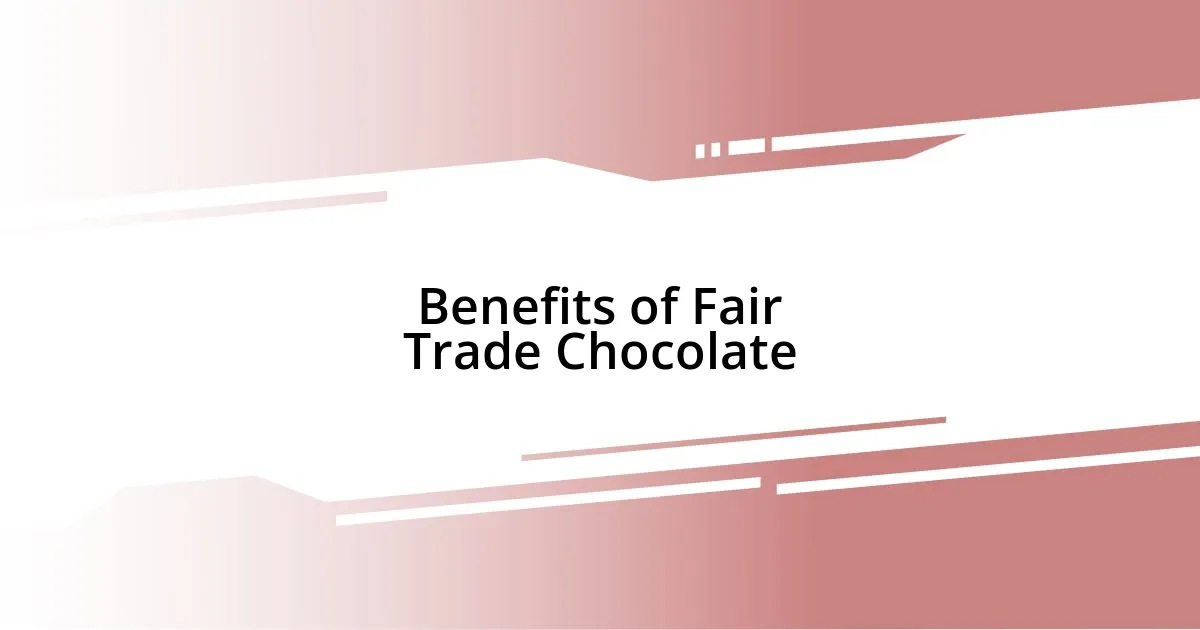Key takeaways:
- Fair trade chocolate embodies ethical practices, ensuring fair wages for cocoa farmers and contributing to community development.
- Choosing fair trade chocolate supports sustainable farming methods and provides consumers with transparency about sourcing.
- Key brands like Green & Black’s, Divine Chocolate, and Alter Eco exemplify the fusion of quality chocolate with social responsibility.
- Making informed chocolate choices can enhance appreciation and promote positive change in farming communities.

Understanding Fair Trade Chocolate
Fair trade chocolate is more than just a label; it’s a commitment to ethical practices that ensure cocoa farmers are paid fairly for their hard work. I remember my first bite of fair trade chocolate, savoring not only the rich flavor but also the knowledge that my purchase was supporting equitable wages. It made me realize how interconnected our choices are with the lives of those who cultivate these precious cocoa beans.
When I think about fair trade, I can’t help but feel a sense of responsibility. Have you ever considered the journey of the chocolate bar in your hand? Each bar represents the labor and dreams of farmers, often from developing countries, striving for better conditions. Fair trade certification seeks to change the traditional exploitative practices by guaranteeing farmers a minimum price and additional premiums that empower them to invest in their communities.
The emotional impact of supporting fair trade chocolate can be profound. Knowing that my choice contributes to sustainable practices and community development helps me appreciate my treat even more. It’s a powerful reminder that every bite can make a difference, transforming indulgence into a meaningful action that supports both people and the environment.

Benefits of Fair Trade Chocolate
The benefits of fair trade chocolate stretch beyond just taste; they resonate deeply with ethical consumption. I remember the first time I learned that my purchase could lead to real change; the thought of my money helping farmers secure better lives felt incredibly empowering. Knowing that fair trade chocolate supports safe working conditions and prevents child labor adds a layer of guilt-free enjoyment to every bite.
Consider some specific benefits of choosing fair trade chocolate:
- Fair Prices: Farmers receive a minimum price for their cocoa, ensuring a stable income for their families.
- Community Investment: Extra premiums from sales are reinvested in community projects like schools and healthcare.
- Sustainable Practices: Fair trade encourages environmentally friendly farming practices, preserving the ecosystem.
- Empowerment: Women in farming communities often gain greater economic independence through fair trade initiatives.
- Transparency: The supply chain is more transparent, allowing consumers to understand where their chocolate comes from.
Every time I unwrap a bar of fair trade chocolate, I think about the stories behind the ingredients. It inspires me to be more intentional with my choices, knowing they can ripple into a farmer’s life, ultimately leading to a healthier community and environment. Isn’t that a sweet thought?

Key Fair Trade Chocolate Brands
When it comes to key fair trade chocolate brands, several stand out for their commitment to ethical practices and high-quality products. For instance, Green & Black’s has been a pioneer in this field, offering a delightful range of organic chocolates that reflect their dedication to sustainable sourcing. I’ve enjoyed their dark chocolate bars countless times, relishing both the taste and the knowledge that my purchase supports fair wages and farming practices.
Then there’s Divine Chocolate, a unique brand owned by cocoa farmers themselves, ensuring that their profits directly benefit the growers. The first time I tried their intense chocolate, I was struck not just by the flavor but also by the story behind it—every bite felt like a celebration of community. It’s brands like these that truly illustrate how chocolate can be both a luxurious treat and a catalyst for positive change.
Another noteworthy brand is Alter Eco, which goes above and beyond in its ethical commitments. I vividly remember savoring their quinoa chocolate bars, and the flavors were not only delicious but also tied to the promise of reforestation and fair compensation for farmers. It’s brands like these that remind me how powerful our choices can be in shaping a more sustainable future.
| Brand | Highlights |
|---|---|
| Green & Black’s | Pioneering organic chocolate with a focus on quality and sustainability. |
| Divine Chocolate | Farmer-owned brand ensuring profits directly support cocoa growers. |
| Alter Eco | Reforestation initiatives and fair compensation for farmers, with unique flavor profiles. |

Evaluating Fair Trade Certifications
Evaluating Fair Trade certifications can be quite enlightening. I remember the first time I dove into what those labels actually mean; it was eye-opening. Not all Fair Trade labels are created equal, and some certifications require stringent audits while others may not have the same rigorous standards. It makes me wonder—how can we as consumers really be sure that our chocolate choices are making a genuine impact?
When I first began exploring Fair Trade brands, I was taken aback by how many certifications exist. The Fair Trade International (FLO) label, for instance, emphasizes social, economic, and environmental standards. On the other hand, the Fair Trade USA certification focuses more on sustainable practices. I thought about how this could confuse consumers. Can you imagine picking up a chocolate bar, wanting to make a difference, only to find that the label on it doesn’t quite deliver on those promises?
As I navigated various brands, I realized that transparency is key. Many Fair Trade certified brands share their sourcing stories, which helped me feel more connected to the farmers behind the chocolate. I found it fascinating to learn about the rigorous criteria that farmers must meet to gain certification. It sparked in me a new appreciation for the chocolate I consume—after all, when I indulge in a piece, I’m not just enjoying a treat; I’m honoring the stories and efforts of those who grow, harvest, and produce it.

Sustainable Practices in Chocolate Production
Sustainable practices in chocolate production are essential for both the environment and the communities involved. I remember learning about shade-grown cocoa farming, which not only protects biodiversity but also creates a habitat for wildlife. It was eye-opening to realize that by choosing chocolate with this method, I’m contributing to the conservation of our planet while enjoying my favorite treat.
Another fascinating aspect is the focus on soil health. Some brands prioritize regenerative agriculture, which improves soil fertility and reduces water consumption. I think back to a visit to a cocoa farm where they practiced this method; the lush, thriving plants were a testament to the positive effects. Seeing firsthand how these practices enhance cocoa quality cemented my belief that sustainability truly enriches the chocolate experience.
Moreover, many chocolate brands are now investing in community-building efforts. I recall reading about a cooperative in West Africa where farmers are not just growing cocoa but also developing skills in sustainable entrepreneurship. The pride in their work was palpable, and it made me think—what if every chocolate bar we enjoyed could support local economies while promoting sustainable practices? It’s a vision I wholeheartedly support, and it reminds me that my chocolate choices can have a ripple effect on the world.

Making Informed Chocolate Choices
Making informed chocolate choices can feel overwhelming at times, but I find that asking the right questions simplifies the process. For example, I often think about where the cocoa beans originate and how the farmers are treated. When I discovered that many brands provide information about their direct trade practices, it not only reassured me but also connected me to the ethos behind the chocolate I enjoy.
I still vividly remember the first time I tried a chocolate bar from a brand that prioritized transparency in its supply chain. As I savored it, I felt a warm connection to the farmers whose stories were shared on the packaging. Knowing that each bite contributed to their livelihoods ignited a deep appreciation—how could I ever return to chocolate that didn’t hold such significance?
It’s fascinating to me how our choices can really drive change. I often ask myself: what kind of impact do I want my purchases to have? As I read labels and researched different brands, I realized that even small actions, like opting for ethically sourced chocolate, can add up to something significant. This journey hasn’t just shaped my chocolate preferences; it’s also opened my eyes to the bigger picture of sustainable consumption and its power.












